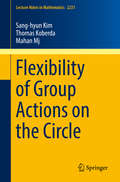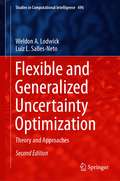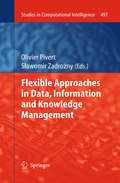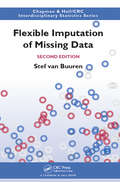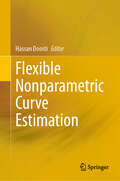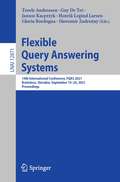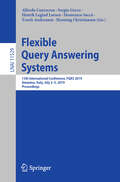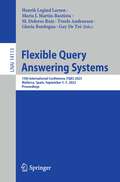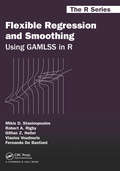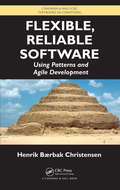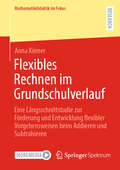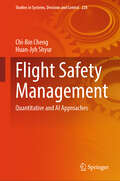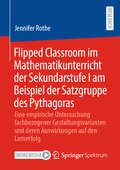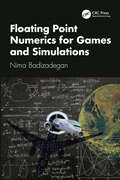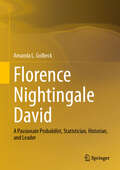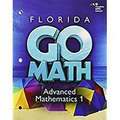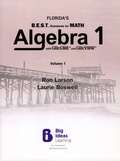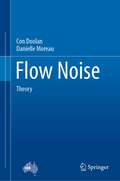- Table View
- List View
Flexibility of Group Actions on the Circle (Lecture Notes in Mathematics #2231)
by Sang-Hyun Kim Thomas Koberda Mahan MjIn this partly expository work, a framework is developed for building exotic circle actions of certain classical groups. The authors give general combination theorems for indiscrete isometry groups of hyperbolic space which apply to Fuchsian and limit groups. An abundance of integer-valued subadditive defect-one quasimorphisms on these groups follow as a corollary. The main classes of groups considered are limit and Fuchsian groups. Limit groups are shown to admit large collections of faithful actions on the circle with disjoint rotation spectra. For Fuchsian groups, further flexibility results are proved and the existence of non-geometric actions of free and surface groups is established. An account is given of the extant notions of semi-conjugacy, showing they are equivalent. This book is suitable for experts interested in flexibility of representations, and for non-experts wanting an introduction to group representations into circle homeomorphism groups.
Flexible and Generalized Uncertainty Optimization: Theory and Approaches (Studies in Computational Intelligence #696)
by Weldon A. Lodwick Luiz L. Salles-NetoThis book presents the theory and methods of flexible and generalized uncertainty optimization. Particularly, it describes the theory of generalized uncertainty in the context of optimization modeling. The book starts with an overview of flexible and generalized uncertainty optimization. It covers uncertainties that are both associated with lack of information and are more general than stochastic theory, where well-defined distributions are assumed. Starting from families of distributions that are enclosed by upper and lower functions, the book presents construction methods for obtaining flexible and generalized uncertainty input data that can be used in a flexible and generalized uncertainty optimization model. It then describes the development of the associated optimization model in detail. Written for graduate students and professionals in the broad field of optimization and operations research, this second edition has been revised and extended to include more worked examples and a section on interval multi-objective mini-max regret theory along with its solution method.
Flexible Approaches in Data, Information and Knowledge Management
by Olivier Pivert Sławomir ZadrożnyThis volume showcases contributions from internationally-known researchers in the field of information management. Most of the approaches presented here make use of fuzzy logic, introduced by L. A. Zadeh almost 50 years ago, which constitute a powerful tool to model and handle gradual concepts. What all of these contributions have in common is placing the user at the center of the information system, be it for helping him/her to query a data set, to handle imperfect information, or to discover useful knowledge from a massive collection of data. Researchers working in data and knowledge management will greatly benefit from this collection of up-to-date studies. This may be also an invaluable source of information for postgraduate students interested in advanced information management techniques.
Flexible Imputation of Missing Data (Chapman & Hall/CRC Interdisciplinary Statistics)
by Stef Van BuurenMissing data pose challenges to real-life data analysis. Simple ad-hoc fixes, like deletion or mean imputation, only work under highly restrictive conditions, which are often not met in practice. Multiple imputation replaces each missing value by multiple plausible values. The variability between these replacements reflects our ignorance of the true (but missing) value. Each of the completed data set is then analyzed by standard methods, and the results are pooled to obtain unbiased estimates with correct confidence intervals. Multiple imputation is a general approach that also inspires novel solutions to old problems by reformulating the task at hand as a missing-data problem. This is the second edition of a popular book on multiple imputation, focused on explaining the application of methods through detailed worked examples using the MICE package as developed by the author. This new edition incorporates the recent developments in this fast-moving field. This class-tested book avoids mathematical and technical details as much as possible: formulas are accompanied by verbal statements that explain the formula in accessible terms. The book sharpens the reader’s intuition on how to think about missing data, and provides all the tools needed to execute a well-grounded quantitative analysis in the presence of missing data.
Flexible Nonparametric Curve Estimation
by Hassan DoostiThis book delves into the realm of nonparametric estimations, offering insights into essential notions such as probability density, regression, Tsallis Entropy, Residual Tsallis Entropy, and intensity functions. Through a series of carefully crafted chapters, the theoretical foundations of flexible nonparametric estimators are examined, complemented by comprehensive numerical studies. From theorem elucidation to practical applications, the text provides a deep dive into the intricacies of nonparametric curve estimation. Tailored for postgraduate students and researchers seeking to expand their understanding of nonparametric statistics, this book will serve as a valuable resource for anyone who wishes to explore the applications of flexible nonparametric techniques.
Flexible Query Answering Systems: 14th International Conference, FQAS 2021, Bratislava, Slovakia, September 19–24, 2021, Proceedings (Lecture Notes in Computer Science #12871)
by Troels Andreasen Guy De Tré Janusz Kacprzyk Henrik Legind Larsen Gloria Bordogna Sławomir ZadrożnyThis book constitutes the refereed proceedings of the 14th International Conference on Flexible Query Answering Systems, FQAS 2021, held virtually and in Bratislava, Slovakia, in September 2021.The 16 full papers and 1 perspective papers presented were carefully reviewed and selected from 17 submissions. They are organized in the following topical sections: model-based flexible query answering approaches and data-driven approaches.
Flexible Query Answering Systems: 13th International Conference, FQAS 2019, Amantea, Italy, July 2–5, 2019, Proceedings (Lecture Notes in Computer Science #11529)
by Alfredo Cuzzocrea Sergio Greco Henrik Legind Larsen Domenico Saccà Troels Andreasen Henning ChristiansenThis book constitutes the refereed proceedings of the 13th International Conference on Flexible Query Answering Systems, FQAS 2019, held in Amantea, Italy, in July 2019.The 27 full papers and 10 short papers presented were carefully reviewed and selected from 43 submissions. The papers present emerging research trends with a special focus on flexible querying and analytics for smart cities and smart societies in the age of big data. They are organized in the following topical sections: flexible database management and querying; ontologies and knowledge bases; social networks and social media; argumentation-based query answering; data mining and knowledge discovery; advanced flexible query answering methodologies and techniques; flexible query answering methods and techniques; flexible intelligent information-oriented and network-oriented approaches; big data veracity and soft computing; flexibility in tools; and systems and miscellanea.
Flexible Query Answering Systems: 15th International Conference, FQAS 2023, Mallorca, Spain, September 5–7, 2023, Proceedings (Lecture Notes in Computer Science #14113)
by Henrik Legind Larsen Maria J. Martin-Bautista M. Dolores Ruiz Troels Andreasen Gloria Bordogna Guy De TréThis book constitutes the refereed proceedings of the 15th International Conference on Flexible Query Answering Systems, FQAS 2023, held in September 2023 in Palma de Mallorca, Spain. The 24 full papers presented were carefully reviewed and selected from numerous submissions. They are organized in the following topical sections: Flexible Queries over Semantic Systems; Advanced Methods and Applications in Natural Language; Processing (NLP); New Advances in Disinformation Detection; Data and Text Mining; Applying AI to Social Science and Social Science to AI; Artificial Intelligence Law and Regulation.
Flexible Regression and Smoothing: Using GAMLSS in R (Chapman & Hall/CRC The R Series)
by Gillian Heller Mikis Stasinopoulos Robert Rigby Fernanda De Bastiani Vlasios VoudourisThis book is about learning from data using the Generalized Additive Models for Location, Scale and Shape (GAMLSS). GAMLSS extends the Generalized Linear Models (GLMs) and Generalized Additive Models (GAMs) to accommodate large complex datasets, which are increasingly prevalent. GAMLSS allows any parametric distribution for the response variable and modelling all the parameters (location, scale and shape) of the distribution as linear or smooth functions of explanatory variables. This book provides a broad overview of GAMLSS methodology and how it is implemented in R. It includes a comprehensive collection of real data examples, integrated code, and figures to illustrate the methods, and is supplemented by a website with code, data and additional materials.
Flexible, Reliable Software: Using Patterns and Agile Development (Chapman & Hall/CRC Textbooks in Computing)
by Henrik B. ChristensenFlexible, Reliable Software: Using Patterns and Agile Development guides students through the software development process. By describing practical stories, explaining the design and programming process in detail, and using projects as a learning context, the text helps readers understand why a given technique is required and why techniqu
Flexibles Rechnen im Grundschulverlauf: Eine Längsschnittstudie zur Förderung und Entwicklung flexibler Vorgehensweisen beim Addieren und Subtrahieren (Mathematikdidaktik im Fokus)
by Anna KörnerDie Entwicklung von Flexibilität beim Rechnen gilt seit vielen Jahren als zentrales Ziel des Arithmetikunterrichts der Grundschule. Dennoch belegen die Ergebnisse empirischer Studien zu Vorgehensweisen von Kindern, dass viele Schüler*innen einen Hauptrechenweg bevorzugen und selten flexibel agieren. Flexibilität scheint sich also nicht automatisch zu entwickeln, sondern muss gezielt gefördert werden. Aufbauend auf Ergebnissen anderer Studien wurde für die vorliegende Untersuchung eine Unterrichtskonzeption zur kontinuierlichen Förderung von Flexibilität vom ersten bis zum vierten Schuljahr entwickelt und umgesetzt. Im Rahmen dieser längsschnittlichen Studie wurden die Vorgehensweisen der Schüler*innen beim Addieren und Subtrahieren sieben Mal im Projektzeitraum in leitfadengestützten Einzelinterviews erfasst, um anhand qualitativer Inhaltsanalyse mit darauf folgender Fallkontrastierung und Typenbildung charakteristische Entwicklungen im Grundschulverlauf rekonstruieren zu können. Alszentrales Ergebnis wird eine Typologie zur Einordnung der Vorgehensweisen beim Lösen von Additions- und Subtraktionsaufgaben vorgestellt, anhand derer Fort- und Rückschritte im Entwicklungsverlauf dokumentiert werden können.
Flight Safety Management: Quantitative and AI Approaches (Studies in Systems, Decision and Control #228)
by Chi-Bin Cheng Huan-Jyh ShyurThis book offers a comprehensive overview of using artificial intelligence and quantitative approaches in many phases of flight safety management, from proactive assessment of potential risks of flights before taking-off to automatic analysis of occurred flight events, for commercial airlines. Flight safety is commonly the core values of airlines. Serious flight disasters always bring tremendous impacts and losses to the industry and the society; thus, airlines and the authorities always treat the issues of flight safety management as the first priority. It presents the information systems that assist the safety staff and managers to adopt preventive operations or to analyze the critical factors or operations that cause a flight event. Such information systems were developed based on artificial intelligence and quantitative approaches, including fuzzy logic, expert systems, deep learning, decision-making methods, reliability theory, and data mining. After introducing the flight safety management practice and common programs, as well as basic artificial intelligence and quantitative approaches, the book describes in detail the information systems we have developed and provides instructions for flight safety practitioners to implement such information systems in their organizations. Case studies collected from the cooperated airline are also presented.
Flipped Classroom im Mathematikunterricht der Sekundarstufe I am Beispiel der Satzgruppe des Pythagoras: Eine empirische Untersuchung fachbezogener Gestaltungsvarianten und deren Auswirkungen auf den Lernerfolg
by Jennifer RotheDas Medium des Lernvideos rückt zunehmend ins Interesse von Lehrkräften zur Vermittlung mathematischer Inhalte. Lernvideos entfalten ihren größten Nutzen, wenn sie inhaltlich ergänzend zu traditionellen Unterrichtsmedien verwendet werden, wie beispielsweise im Rahmen der Flipped-Classroom-Methode. Zur konkreten Umsetzung geflippten Mathematikunterrichts existiert allerdings kein Standardverfahren. Daher werden in dieser Arbeit zunächst theoriegeleitet fachbezogene Gestaltungselemente geflippten Fachunterrichts konzeptualisiert. Diese beziehen sich auf das Anspruchsniveau des Lernvideoinhalts (gering oder erhöht), die Art dieses Videoinhalts (Einführungs- oder Lösungsbeispielvideos) sowie die Art des Übens in der Präsenzphase (erweitertes Einüben im eigenen Tempo oder Bearbeitung eines Vertiefungsproblems). Diese werden in einer Mixed-Methods-Studie hinsichtlich ihrer Eignung zur Gestaltung von Mathematikunterricht und des zu erwartenden Lernerfolgs im Vergleich zum Regelunterricht untersucht. Die Ergebnisse zeigen einige besonders geeignete Gestaltungsvarianten geflippten Mathematikunterrichts für die Schulpraxis auf, mit denen Teile der Lernenden einen verbesserten Lernerfolg im Vergleich zum Regelunterricht zeigen.
Floating Point Numerics for Games and Simulations
by Nima BadizadeganFloating point is ubiquitous in computers, where it is the default way to represent non-integer numbers. However, few people understand it. We all see weird behavior sometimes, and many programmers treat it as a mystical and imprecise system of math that just works until it sometimes doesn’t. We hear that we shouldn’t trust floating point with money, we know that 0.1 + 0.2 does not equal 0.3, and “NaN” shows up in our logs when things break. We rarely hear why any of this is the case, and less about what to do about it.This book pulls back the veil on floating point and shows how this number system we program with every day works. It discusses how to leverage the number system for common calculations, particularly in graphics and simulations, and avoid pitfalls. Further, we will review methods that can give you either better performance or better accuracy on tasks like numerical integration and function approximation, so you can learn to make the right tradeoffs in your programs.This book builds upon a basic knowledge of calculus and linear algebra, working with illustrative examples that demonstrate concepts rather than relying on theoretical proofs. Along the way, we will learn why Minecraft has struggled with boat physics and what the heck John Carmack was thinking with Quake III’s infamous fast reciprocal square root algorithm. By the end of the book, you will be able to understand how to work with floating point in a practical sense, from tracking down and preventing error in small calculations to choosing numerical building blocks for complex 3D simulations. Gives insight into how and why floating-point math works Describes how floating-point error arises and how to avoid it Surveys numerical methods important to graphics and numerical simulations Includes modern techniques to apply to your numerical problems Shows how to hack the floating-point numbers to compute faster and more accurately
Florence Nightingale David: A Passionate Probabilist, Statistician, Historian, and Leader
by Amanda L. GolbeckThis book examines Florence Nightingale David's life, contributions, and relationships throughout her life, as well as her subsequent legacy. Florence Nightingale David (1909-1993) was the first woman professor in the world's first academic statistics department, served in various British ministries during the war from 1939-1945, and was one of the first women to chair a statistics department in a research university. In this biography, the life stories of David are used as a vehicle to explore a variety of questions surrounding culture and engagement in the statistical sciences. What does it take to succeed in an environment that is not inclusive of your demographic? How can stories be used to bring technical material to life for students and other learners? And how can a nontraditional leader succeed in challenging boundaries and moving an enterprise forward?
Florida Benchmarks Practice Book for Home or School, Grade 1
by Houghton Mifflin HarcourtMath Activity Book-Grade 1: Florida Edition
Florida Benchmarks Practice Book for Home or School, Grade 2
by Houghton Mifflin HarcourtA math workbook in English and Spanish
Florida Go Math: Mathematics 2
by Edward B. Burger Juli K. Dixon Timothy D. Kanold Matthew R. Larson Steven J. Leinwand Martha E. Sandoval-MartinezStandards for Mathematical Practice. The topics described in the Standards for Mathematical Content will vary from year to year. However, the way in which you learn, study, and think about mathematics will not. The Standards for Mathematical Practice describe skills that you will use in all of your math courses. These pages show some features of your book that will help you gain these skills and use them to master this year's topics.
Florida Go Math Advanced Mathematics 1
by Edward B. Burger Juli K. Dixon Timothy D. Kanold Matthew R. LarsonA mathematics textbook for middle school
Florida Go Math! Pre-Algebra
by Edward B. Burger Juli K. Dixon Timothy D. Kanold Matthew R. Larson Steven J. Leinwand Martha E. Sandoval-MartinezMiddle School Math Workbook
Florida's B.E.S.T. Standards for Math-Algebra 1 w/CalcChat & CalcView Vol 1
by Ron Larson Laurie BoswellThis algebra workbook is an essential resource for intermediate students who want to excel in mathematics. It contains a wealth of information, including lessons, practice problems, and exercises that cover a variety of algebraic concepts. The publication, B.E.S.T. Standards for Math Algebra 1 with CalcChat & CalcView, is authored by Ron Larson and Laurie Boswell and published by Big Ideas Learning. This paperback workbook has a unit format and is part of the FL series. It was published in 2023 in the United States and is written in English. It features CalcChat, which is an online platform that allows students to receive instant feedback on their work. The book is suitable for personal use and is not personalized.
Flow Noise: Theory
by Con Doolan Danielle MoreauThis book highlights the importance of sound produced by fluid flow or flow-induced noise. Noise created by unsteady flow creates high levels of environmental noise pollution, a known public health problem, and can compromise the acoustic qualities of marine vessels. There is a seemingly ever-growing list of modern technology that created flow-induced noise which includes aircraft, wind turbines, submarines, drones, high-speed rail, and cooling fans. More scientists and engineers are required to incorporate the effects of flow-induced noise in their work. This book also provides a comprehensive introduction to the theory underpinning the understanding of flow-induced noise.
